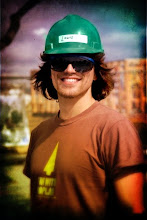Since I was 5 years old, I saw the world through brown, Swedish-designed goggles. They protected my eyes from the blinding sun and the stinging chlorine. These goggles also protected my pride, especially when I cried in them during difficult swimming sets as 12-year old girls were lapping me. I wore these goggles throughout my workouts, and even during the times I wasn't swimming-- since a huge white streak-mark permanently tanned my face. They marked my identity as a swimmer if the bleached hair and sterilized smell of chlorine did not give me away first.
After the summer of 2008, I officially hung those goggles up. Though I now wear a different type of goggles. They are called Peace Corps Goggles and they are quite a trip. I imagine them to be like a pair of beer goggles, distorting your vision, skewing your judgment and messing with your senses, but these PC goggles are permanent. They can't be taken off after a long night's sleep and a morning's headache.
The first thing to go were my taste buds. In America, I remember all my meals with meat and cheese, herbs and spices, caramel-coated popcorn and 37 flavors of ice cream. A standard American recipe would have at least 17 ingredients and 5 spices which you could prepare and then stick into an easy-bake oven so you could preemptively work off the calories with a television aerobics class while it cooks. But in Kenya, the ingredient list for the staple food is:
*Water
*Corn Flour
And I cook this meal for myself 5 times a week. I don't know how, but I simply love it. Together with some fried kale and this meal is something to look forward to each night. I have no other explanation than suspecting that my taste buds are peering through some darkly-tinted Peace Corps Goggles.
In America, I was very used to scantily-dressed women on television and road-side advertisements. 13-year old girls could publicly dress in next to nothing and I would think it was perfectly acceptable. But now this is not the case. If I see a Kenyan girl wearing a pair of tight jeans or if I see bare shoulders, I think to myself that the girl is awfully bold to dress so precariously. As an example, my friend sent me a copy of the “Rolling Stone” magazine the other day with a picture of Lady Gaga with a couple machine guns and a few strips of leather that covered just enough. As soon as I looked at this cover I instinctively shut my eyes and turned my head away from the picture. I was not at all used to seeing so much of the skin of a woman.
As an adolescent, I was awfully picky when it came to beauty. I had a list of criteria that would be scrutinized for any lady who happened upon my path, from skin tone, wrist size, eye color, and vocal melody. It may be shameful to admit, but my sister would often ask me my opinion about a girl she pulled up from “hot-or-not.com” (sorry sister for calling you out on that one), and I would systematically place her through my analysis. But with my brand new set of Peace Corps Goggles, I find myself in a different place. Her feet may be calloused and wrinkled, her hands weathered from manual labor, and her voice low and hoarse—she is beautiful. I see a fat mama carrying a child on her back and a 20 liter jerry can of water on her head—a beautiful lady. It's gotten to a point where I just say to myself, “Is that a woman??...Beautiful.”
These goggles also make me frightened of white people. Whenever I see a tourist I try not to stare too long and walk the other way. White people are like the little ghost demons in pac-man, and I am like the little pac-man, avoiding them at all costs. Especially if I see a white person in my village—I think to myself that they do not belong.
Witnessing physical pain is no big deal anymore, and harsh working conditions, unfair wages, mistreatment of animals...these have all become daily occurrences. I visited a “fair trade” shop where people were paid about 2 dollars for 8 hours of manual labor in a dilapidated shop with poor ventilation. If I were fresh from America, I would scream at the injustice and write a moving book on working conditions in Africa. But after just four months in Kenya I saw that shop and said to myself, “These people have tools to work with and stools to sit on. And these people have jobs! Wonderful. I support them.”
Even the capital punishment used in school systems have given way to the rosy-red tint of my shiny goggles. When I first arrived at site, I remembered hearing the shrill screams of children at the nearby school and I remembered hating it. But now when I walk by schools and children run to the gates and scream, “Mzungu! Give me money! Give me sweets!” and the teacher grabs them and starts beating them with a stick, I think to myself, “Good work, teacher.” One time I actually thanked a teacher for punishing a child when he begged me for money.
It has been just 8 months in Kenya. I have 18 more. And these Peace Corps Goggles can only get darker. I am simultaneously frightened and intrigued at what I will be peering through by the end of my journey.
Subscribe to:
Post Comments (Atom)

No comments:
Post a Comment